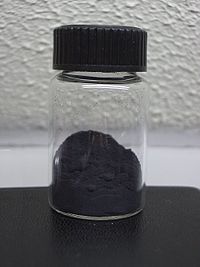
Photo from wikipedia
Two-coordinate carbene-MI-amide (cMa, MI = Cu, Ag, Au) complexes have emerged as highly efficient luminescent materials for use in a variety of photonic applications due to their extremely fast radiative… Click to show full abstract
Two-coordinate carbene-MI-amide (cMa, MI = Cu, Ag, Au) complexes have emerged as highly efficient luminescent materials for use in a variety of photonic applications due to their extremely fast radiative rates through thermally activated delayed fluorescence (TADF) from an interligand charge transfer (ICT) process. A series of cMa derivatives was prepared to examine the variables that affect the radiative rate, with the goal of understanding the parameters that control the radiative TADF process in these materials. We find that blue-emissive complexes with high photoluminescence efficiencies (ΦPL > 0.95) and fast radiative rates (kr = 4 × 106 s-1) can be achieved by selectively extending the π-system of the carbene and amide ligands. Of note is the role played by the increased separation between the hole and electron in the ICT excited state. Analysis of temperature-dependent luminescence data and theoretical calculations indicate that the hole-electron separation exerts a primary effect on the energy gap between the lowest-energy singlet and triplet states (ΔEST) while keeping the radiative rate for the singlet state relatively unchanged. This interpretation provides guidelines for the design of new cMa derivatives with even faster radiative rates in addition to those with slower radiative rates and thus extended excited state lifetimes.
Journal Title: Journal of the American Chemical Society
Year Published: 2022
Link to full text (if available)
Share on Social Media: Sign Up to like & get
recommendations!